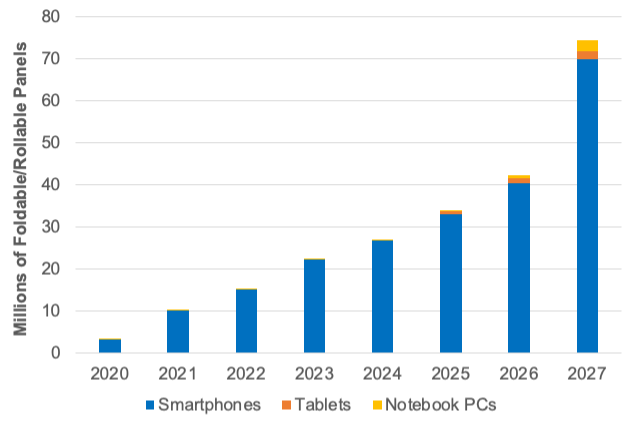Surging on Smartphones, Folding Screen Adoption on Laptops Will Take Years to Go Mainstream
A study predicts a significant dent only in 2027.

Much as with some smartphones, folding displays have allowed for large-screen PCs you can slip into your bag. With the Spectre Foldable, HP recently became the third major vendor to release such a model in the U.S., following Lenovo, which recently followed up its first market entry with its delayed second-generation, larger ThinkPad X1 Fold, and Asus, which has its Zenbook 17 Fold OLED. (LG has shown a version of its Gram laptop with a folding display, but is releasing it only in South Korea to start.)
But the foldable form factor has gotten off to a slow start in its first three years, and we shouldn’t expect it to overcome traditional laptops anytime soon. The latest data from Display Supply Chain Consultants (DSSC) shows that, for the foreseeable future, notebooks will represent a tiny fraction of the total number of devices shipped with foldable displays. Foldable phones are expected to outpace PCs well beyond the next five years.
Some of that disparity reflects the relative volumes of both device classes. For 2022, IDC pegged the number of smartphones shipped at 1.21 billion units (the lowest number since 2013) and the number of PCs (including desktops) shipped at 292.3 million. But the 4x unit advantage that smartphones have over PCs can’t fully account for the far greater uptake among current and projected smartphone users. There are a number of challenges that foldable PCs face that phones don't.
Since folding displays for notebooks are much larger than folding displays for smartphones; they are more expensive and add more to the device price. But there are otyfactors at play. For one, regardless of whether a phone folds vertically (Samsung Galaxy Flip, Moto Razr) to take up less pocket space or horizontally (Google Pixel Fold, OnePlus Open), opening into a small tablet, they remain useful when they’re folded thanks to their external displays. But while today’s laptops with folding displays can act as a tablet or portable desktop, they rely on Bluetooth keyboards and trackpads or mice to deliver a complete laptop experience.
And PC makers are still figuring out exactly what a foldable PC should look like in the first place. With the first ThinkPad X1 Fold, Lenovo stuck with the popular 13-inch laptop screen size, but that limited people to 9.5-inches in laptop mode. On the Asus Zenbook 17 Fold, the company used a screen that could be damaged by a stylus. While HP solved some of these issues in the HP Spectre Fold, that machine costs $5,000, which is too expensive to go mainstream.
Finally — and this holds true for Lenovo’s compelling dual-screened Yoga Book 9i as well — taking full advantage of a folding screen requires a bit of deconstruction. The separate keyboard and trackpad, as well as a stylus or optional mouse, may need to be carried(and possibly charged) separately from the rest of the device. Some, like the HP Spectre, have gotten around this with wireless charging from the system to the accessories. But these compromise the convenience of the laptop experience and turn the notebook experience into a desktop experience that must be stacked again when transported.
To some, the bigger screen for a desktop-style experience may be a benefit. But it's definitely more cumbersome than phones, which simply fold open and close to grow and shrink. The experience is largely the same as with non-foldable phones, and at least the product stays in one piece.
These are early days for folding notebook displays, and many of these issues can be addressed or at least improved. But for at least the first devices out of the gate, folding displays don’t add the same kind of value to the notebook experience that they do to the smartphone experience. Some of that is due to software. While Android is adding features to improve support for folding displays, Windows 11 doesn't feel built for them, and the hardware manufacturers have all built on top of the OS to compensate for it.
Get Tom's Hardware's best news and in-depth reviews, straight to your inbox.
As for why the overall shipment numbers jump 75% in 2027, that is when DSCC expects Apple to release a foldable device, likely an iPhone, with a bang, shipping over 10 million units to its high-end customer base. Some rumors are that Apple's foldable device will be an iPad, which might put all of those devices in a separate category. Still, when Apple jumps into a trend, the market tends to look at it more seriously. So it looks as if the iPad mini is safe for at least another few years.
